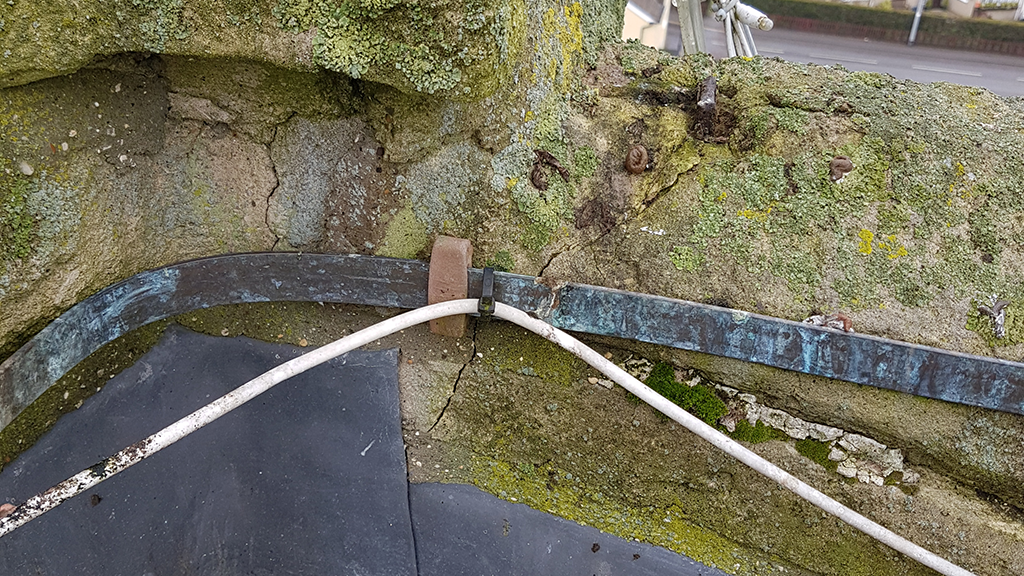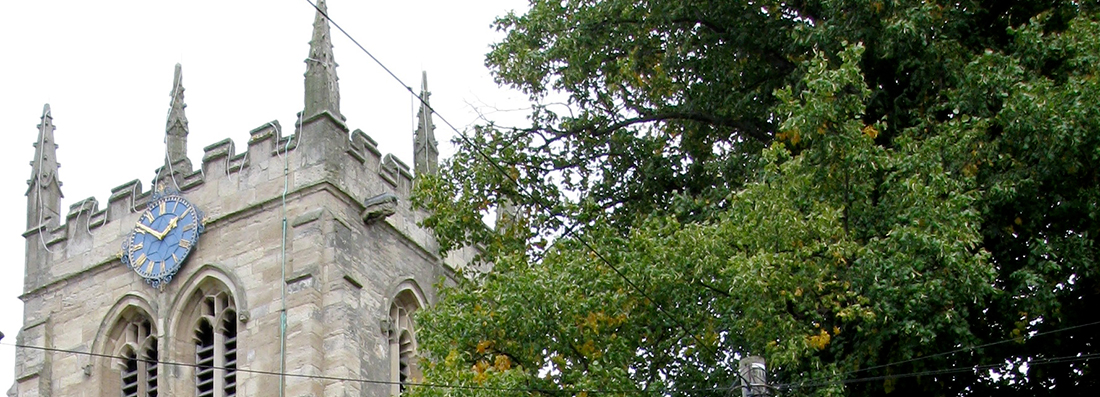As part of our ongoing church maintenance programme survey, last year at St Cuthbert’s we uncovered a loose pinnacle on the church tower, namely the west side central pinnacle situated above the clock.
Background
We have been using the SPAB’s Maintenance Programme and steadily completing parts of a detailed survey of the church. One of my tasks this Spring was to remove the historic aged permanently fixed Christmas lights from the tower, quite a job in its own right and, as we were doing that task, we made additional checks to update our survey record.
Removing the Christmas lights meant wearing a safety harness and leaning out through the castellations and, whilst doing this, some moss and lichen was brushed away revealing a steel peg. At some time in the distant past this must have been hammered into the stonework on one side of the west side central pinnacle. A further examination found an identical peg on the other side of the west central pinnacle, which we found repeated either side of the east central pinnacle. A photo of one peg showing the major inboard crack can be seen below.
Serious problem
Photographs from at least 50 years ago, maybe more, show a flag pole on top of the tower, and these steel pegs must have been part of the support structure. The steel pegs have rusted and, on the west central pinnacle, cracked the supporting stones on either side. We also found that on the front face, running down from the base of the pinnacle into the wall and along the mortar line down behind the clock, a long fresh crack that overall extends for circa 500mm.
We reported this to our architect Chris Cotton of Purcell who suggested we urgently carry out a very gentle ‘rocking’ test to see if there was any movement. After fixing a safety rope to retain it on the wall, we saw movement deep into the wall below the pinnacle – making it plain that we had a serious problem.
We swiftly moved to secure it by using heavy rope, tying the west central pinnacle back to the masonry at the east side corners so it could not fall outwards.

Quick thinking
Our worry was that, with strong westerly winds forecast the whole structure could have fallen inwards, all the way to the floor of the tower.
So after discussions with Purcell it was clear we had to devise a better solution. We took heavy steel scaffold tubes up the tower stairway onto the tower roof and created a rigid structure behind it, supported from the gutters, to ensure it could not fall inwards. We also applied a robust series of straps to prevent it falling outwards, lashed it all together so that it could not move, and reported back to Purcell.
We then had it all inspected by Chris Cotton who approved the support structure. In his opinion the whole pinnacle needed to be taken down as soon as possible. Chris also noticed that on the front face, a horizontal joint just above the base had opened, which suggests that water may have penetrated and, if there was an iron pin providing a location, it may have rusted and steadily forced the whole pinnacle upwards and slightly backwards. He also commented that the cracks in the wall mentioned above may or may not be connected, and until the pinnacle is taken off safely and examined, we cannot be certain of what needs to be done to repair and restore or even replace.
We had a visit from the Stone Technical Services Group who concurred with Chris Cotton that it must be taken down immediately, and that it is probably as-built in the 11th century. The Stone TSG staff member approved the current support structure as being safe and adequate, but also felt that the pinnacle should be taken down as a matter of urgency to comply with the precautions that should be taken from a Health and Safety perspective.
Removal
Stone TSG were then faced with the challenge of first working out how to take the pinnacle down safely whilst working at height and, then, how to lower it to the ground. It seemed fairly certain at this stage that it would not be possible to employ a crane and that the whole job might have to be done at the top of the tower.
In the circumstances, and because of the complexities involved in removing this pinnacle safely, which probably weighs at least 1.5 tonnes, what we submitted for faculty approval at this first stage was just for the removal, to ground level. As will be appreciated, it is impossible to predict what will be required beyond this point, prior to a detailed inspection of all the parts and the wall after the removal of the loose pinnacle.
Other pinnacles have had to be checked, as we are now aware of one other pinnacle (directly opposite, east side central) that may also develop similar problems in the future. Once quotations have been advised and faculty permission granted for removal and the process duly completed, only then will we, with our advisers, be able to accurately assess what needs to be done and seek the relevant specifications for repairs, reinstatement and relevant permissions.
If ever there was 100% justification for your introduction of the Maintenance Programme Survey, you sure have it and a good story!

